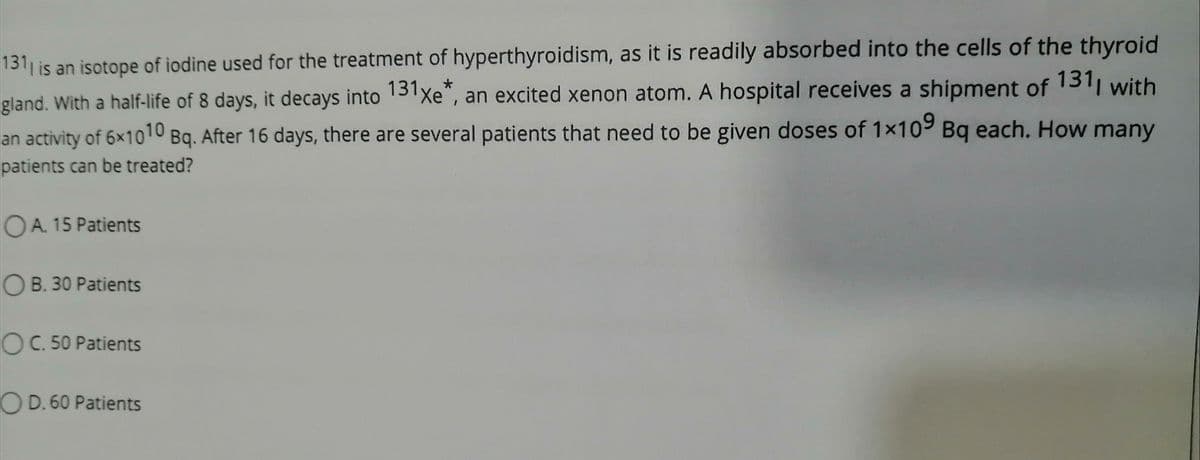A is a radioactive substance with a half-life of 2 hours. B is a radioactive substance with a half-life of 1 hours. Substance B initially has twice as many atoms of substance A. Which of the following statements about samples A and B is true? A. After 1 hour, a larger percentage of undecayed atoms will be left in sample B than in sample A. B. After 1 hour, a larger number of atoms will have decayed in sample A than in sample B. C. After 2 hours, both samples will have the same number of undecayed atoms. D. After 2 hours, the same number of atoms will have decayed in both samples.
A is a radioactive substance with a half-life of 2 hours. B is a radioactive substance with a half-life of 1 hours. Substance B initially has twice as many atoms of substance A. Which of the following statements about samples A and B is true? A. After 1 hour, a larger percentage of undecayed atoms will be left in sample B than in sample A. B. After 1 hour, a larger number of atoms will have decayed in sample A than in sample B. C. After 2 hours, both samples will have the same number of undecayed atoms. D. After 2 hours, the same number of atoms will have decayed in both samples.
Chemistry: Principles and Reactions
8th Edition
ISBN:9781305079373
Author:William L. Masterton, Cecile N. Hurley
Publisher:William L. Masterton, Cecile N. Hurley
Chapter18: Nuclear Reactions
Section: Chapter Questions
Problem 56QAP
Related questions
Question

Transcribed Image Text:A is a radioactive substance with a half-life of 2 hours. B is a radioactive substance with a half-life of 1 hours. Substance B
initially has twice as many atoms of substance A. Which of the following statements about samples A and B is true?
A. After 1 hour, a larger percentage of undecayed atoms will be left in sample B than in sample A.
B. After 1 hour, a larger number of atoms will have decayed in sample A than in sample B.
OC. After 2 hours, both samples will have the same number of undecayed atoms.
D. After 2 hours, the same number of atoms will have decayed in both samples.

Transcribed Image Text:1311 is an isotope of iodine used for the treatment of hyperthyroidism, as it is readily absorbed into the cells of the thyroid
1311 with
gland. With a half-life of 8 days, it decays into 131 xe*, an excited xenon atom. A hospital receives a shipment of
an activity of 6x1010 Bq. After 16 days, there are several patients that need to be given doses of 1×109 Bq each. How many
patients can be treated?
OA. 15 Patients
OB. 30 Patients
OC. 50 Patients
OD. 60 Patients
Expert Solution
This question has been solved!
Explore an expertly crafted, step-by-step solution for a thorough understanding of key concepts.
This is a popular solution!
Trending now
This is a popular solution!
Step by step
Solved in 2 steps

Knowledge Booster
Learn more about
Need a deep-dive on the concept behind this application? Look no further. Learn more about this topic, chemistry and related others by exploring similar questions and additional content below.Recommended textbooks for you

Chemistry: Principles and Reactions
Chemistry
ISBN:
9781305079373
Author:
William L. Masterton, Cecile N. Hurley
Publisher:
Cengage Learning

Chemistry by OpenStax (2015-05-04)
Chemistry
ISBN:
9781938168390
Author:
Klaus Theopold, Richard H Langley, Paul Flowers, William R. Robinson, Mark Blaser
Publisher:
OpenStax

General Chemistry - Standalone book (MindTap Cour…
Chemistry
ISBN:
9781305580343
Author:
Steven D. Gammon, Ebbing, Darrell Ebbing, Steven D., Darrell; Gammon, Darrell Ebbing; Steven D. Gammon, Darrell D.; Gammon, Ebbing; Steven D. Gammon; Darrell
Publisher:
Cengage Learning

Chemistry: Principles and Reactions
Chemistry
ISBN:
9781305079373
Author:
William L. Masterton, Cecile N. Hurley
Publisher:
Cengage Learning

Chemistry by OpenStax (2015-05-04)
Chemistry
ISBN:
9781938168390
Author:
Klaus Theopold, Richard H Langley, Paul Flowers, William R. Robinson, Mark Blaser
Publisher:
OpenStax

General Chemistry - Standalone book (MindTap Cour…
Chemistry
ISBN:
9781305580343
Author:
Steven D. Gammon, Ebbing, Darrell Ebbing, Steven D., Darrell; Gammon, Darrell Ebbing; Steven D. Gammon, Darrell D.; Gammon, Ebbing; Steven D. Gammon; Darrell
Publisher:
Cengage Learning

Principles of Modern Chemistry
Chemistry
ISBN:
9781305079113
Author:
David W. Oxtoby, H. Pat Gillis, Laurie J. Butler
Publisher:
Cengage Learning

Chemistry & Chemical Reactivity
Chemistry
ISBN:
9781337399074
Author:
John C. Kotz, Paul M. Treichel, John Townsend, David Treichel
Publisher:
Cengage Learning

Chemistry: The Molecular Science
Chemistry
ISBN:
9781285199047
Author:
John W. Moore, Conrad L. Stanitski
Publisher:
Cengage Learning